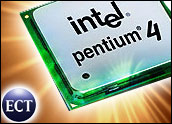
Intel has revealed plans to extend the number of transistors the company can put on chips with existing equipment. The next-generation technique includes a 65-nanometer process that the company said will help develop more capable processors and larger, more cost-effective 300-nanometer wafers, which are used for processors and other semiconductor manufacturing products.
The Santa Clara, California chip company said it will begin producing processors with the new manufacturing techniques in 2005, when it will be able to double the number of transistors the company can put on a single chip today.
The company detailed other new components of its next-generation process, including a new version of RAM built with the 65-nanometer technology, a new copper manufacturing process that will help with power efficiency, and new techniques that will help extend the life of existing semiconductor manufacturing equipment.
Tinier Transistors
“This accomplishment puts Intel’s 65-nanometer technology on a fast track to extend our 15-year record of ramping production on a new process generation every two years,” said Intel senior vice president and general manager of technology and manufacturing Sunlin Chou.
“The 65 nanometer process will enable us to make better products at lower cost, as we continue to innovate and extend Moore’s Law,” he said, referring to Gordon Moore, an Intel cofounder who said that the number of transistors on a chip will double every 18 months.
While Intel is in the middle of a rapid ramp-up of its products from the older 130-nanometer process to the newer 90-nanometer process, the company is also now laying the groundwork for even smaller transistors that would be built with the 65-nanometer process.
Intel said the transistors made from the 65-nanometer process will actually measure only 35 nanometers in gate length, “which will be the smallest and highest-performing CMOS transistors in high-volume production,” the company said.
“Small, fast transistors are the building blocks for very fast processors,” Intel said.
Continual March
Meta Group vice president Steve Kleynhans told TechNewsWorld that Intel’s demonstration is part of the company’s “continual march” forward that includes steps such as the 90- and 65-nanometer processes roughly every two years.
Kleynhans said there are rough spots with every shift, but Intel — which used a relatively simple RAM design to demonstrate the 65-nanometer process — tends to succeed in moving the technology to more complex chips, such as microprocessors.
“This doesn’t prove unequivocally they can make the chip now, but they’ve got a pretty good track record here,” Kleynhans said.
New Life for Equipment
Giving credit to its in-house manufacturing team, Intel also said it would be able to reuse existing lithography equipment in the next-generation 65-nanometer process. The company said it expects the process to shift into high-volume production at its Hillsboro, Oregon fabrication facility starting in 2005.
“Overall, the most significant thing is the fact that they were able to keep using the same equipment,” Kleynhans said. “That’s where a huge piece of cost is.”
Kleynhans said another generation of chips from the same equipment will likely mean the 65-nanometer process will roll out rapidly when it is ready for production because the tools are in place and familiar. “It definitely keeps costs down and translates to them having a pretty good competitive weapon,” Kleynhans added.
Pressure Points
Analysts agreed that Intel is gaining more control over price as it pushes forward on smaller transistors and faster chips, putting pressure on rivals such as Advanced Micro Devices, which last week announced construction of a new 300-nanometer manufacturing facility in Germany.
“Competitors like AMD will rely on other measures, like relatively compact die sizes, to keep their production costs competitive,” IDC senior analyst Shane Rau told TechNewsWorld.
Still, Kleynhans said Intel and its competitors are also facing the challenge of offering a reason for the new, faster chips. “The transistors are smaller and faster, but one could ask whether people are looking for smaller, faster processors,” Kleynhans said. “It’s kind of a crossroads at Intel’s end and really for the whole industry.”
The new developments will likely force Intel to think more creatively about using those transistors, Kleynhans added. “They need to be not just faster, but they have to do better in other ways.”











































